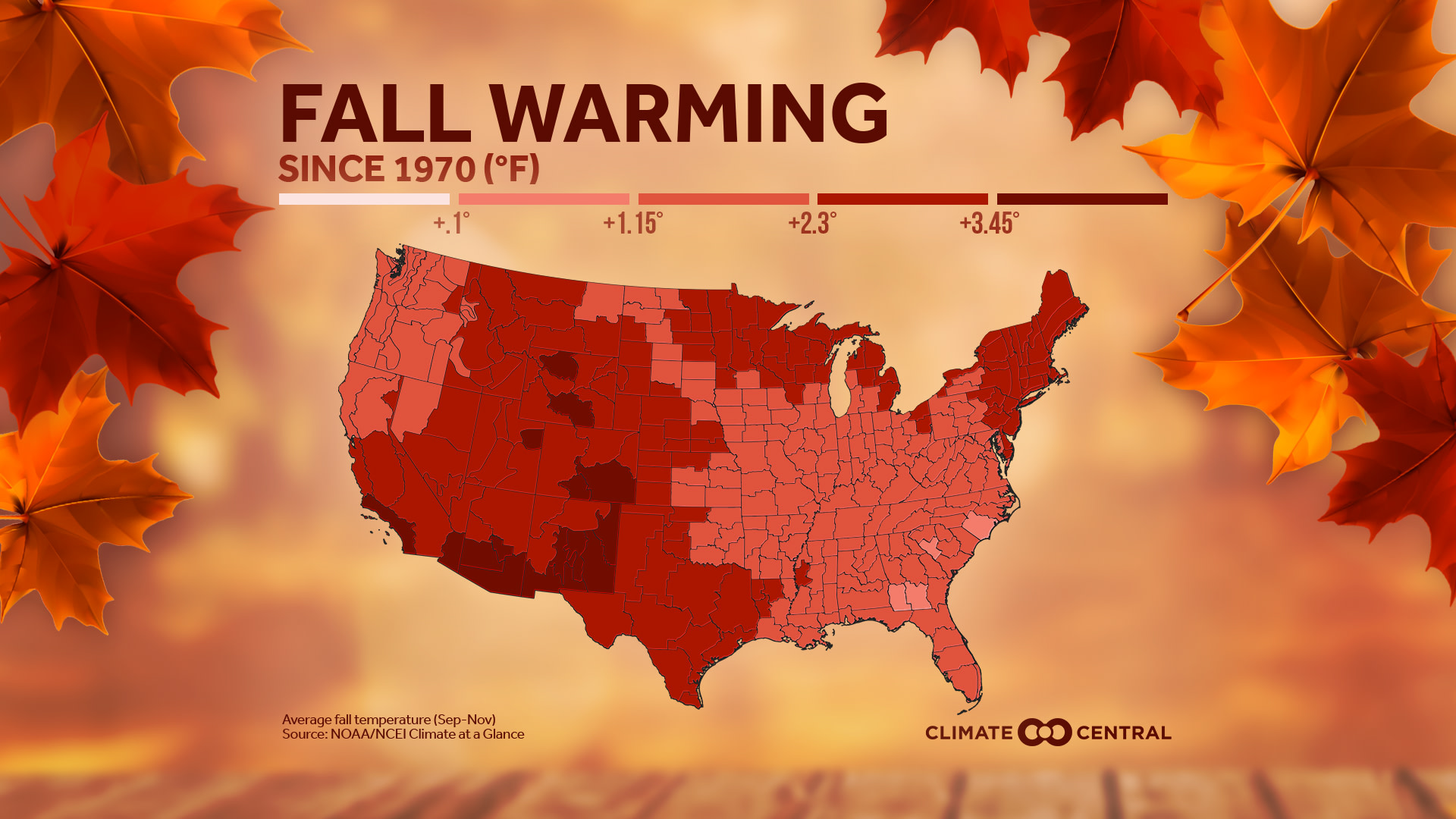KEY CONCEPTS
Summer heat is invading the fall season. Of the 242 cities analyzed, 95% (230) experienced an increase in their average fall temperatures since 1970. A little more than half (120 of 230) of those cities saw an increase of over 2℉.
Our analysis shows that 64% (155) of 242 cities had at least seven additional days above their normal fall temperatures since 1970, with eight cities reporting more than 30 additional days.
Higher cooling demands and a longer mosquito and tick season creep later into the year as climate change heats up autumn across the country. Additionally, allergy sufferers will endure an extended pollen season—a direct result of delayed cooler fall temperatures prolonging the growing season.
Mosquitoes, ticks and pollen could be mainstays of fall as climate change extends summer heat.
For meteorological fall (September 1st), we’re updating popular fall analyses, including:
Average Fall Temperatures (local trend and a national map)
Fall Days Above Normal
Of the 242 cities analyzed, 95% (230) reported an increase in their average fall temperatures since 1970. Of the cities that recorded an increased trend, 52% (120 of 230) experienced warming of more than 2℉. This trend is observed across the nation, but the top five greatest increases in average fall temperatures are clustered in Texas and the Southwest region. Reno, Nev. easily garnered the first place spot with the highest increase of 7.5℉, not far followed by Las Vegas, Nev. (5.7℉), El Paso, TX. (5.4℉), Tucson, Ariz. (5.1℉), and Phoenix, Ariz. (5℉).
The number of fall days above normal also reflect a warming trend. Our analysis revealed that 64% (155) of 242 cities recorded at least seven additional days above their normal fall average temperature since 1970. Further, eight cities saw at least 30 additional days—a whole month—above normal, with Reno, Nev. reaching almost 43 more days.
The extended warmth may sound inviting to some but has implications, such as an extended season of disease-carrying mosquitoes and ticks and higher cooling demands as air conditioners run later into the year. A warmer fall is also bad news for allergy sufferers because delayed cooler fall temperatures extend the growing season—and thus, the allergy season. In the past 12 months, there were 12 million physician office visits for hay fever, and this number will only rise as plants, like ragweed, continue to produce pollen later into the fall months.
POTENTIAL LOCAL STORY ANGLES
How will a warmer fall affect cooling demands in your region? With a warmer fall season, some regions are relying on air conditioning for longer. The EIA estimates that air conditioning accounts for 12% of U.S. homeowners’ energy bills on average—you can discover specific estimates by region here. In addition, the concurrent hurricane season can cause large power outages, posing risks to cooling demands. Check out Poweroutages.us, which tracks, records and aggregates power outage data across the U.S. in an informative and up to date map.
What does a longer pollen season mean for allergy sufferers near you? A longer growing season means a longer allergy season, exemplified by the extension of the ragweed pollen season across the U.S. The Asthma and Allergy Foundation of America (AAFA)’s Allergy Capitals report can determine which cities have the highest pollen counts, use of allergy medications, and number of allergy specialists.
EXPERTS TO INTERVIEW
Local Experts
The SciLine service, 500 Women Scientists or the press offices of local universities may be able to connect you with local scientists who have expertise on the warming fall season in your area. The American Association of State Climatologists is a professional scientific organization composed of all 50 state climatologists.
National Experts
Amanda Gallinat
Postdoctoral Researcher in the Pearse Lab
Utah State University
Department of Biology & Ecology Center
Discussion topics: Climate change and evolutionary ecology
Lead Author, Autumn, the Neglected Season in Climate Change Research
Kenneth Mendez
President and CEO
Asthma and Allergy Foundation of America (AAFA)
Discussion topics: Longer allergy season
Interviews arranged by public relations director at kbrown@aafa.org
METHODOLOGY
Fall (September through November) trends were calculated using data from the Applied Climate Information System from 1970-2019. Fall days above normal are relative to the 1981-2010 NCEI climate normal. Changes in average temperature since 1970 for US climate divisions were calculated using data from NOAA/NCEI. Displayed trend lines on city analysis are based on a mathematical linear regression. Climate Central’s analyses include 244 states, however, only 242 stations are included due to large data gaps in St. Johnsbury, Vt. and Wheeling, W. Va.
